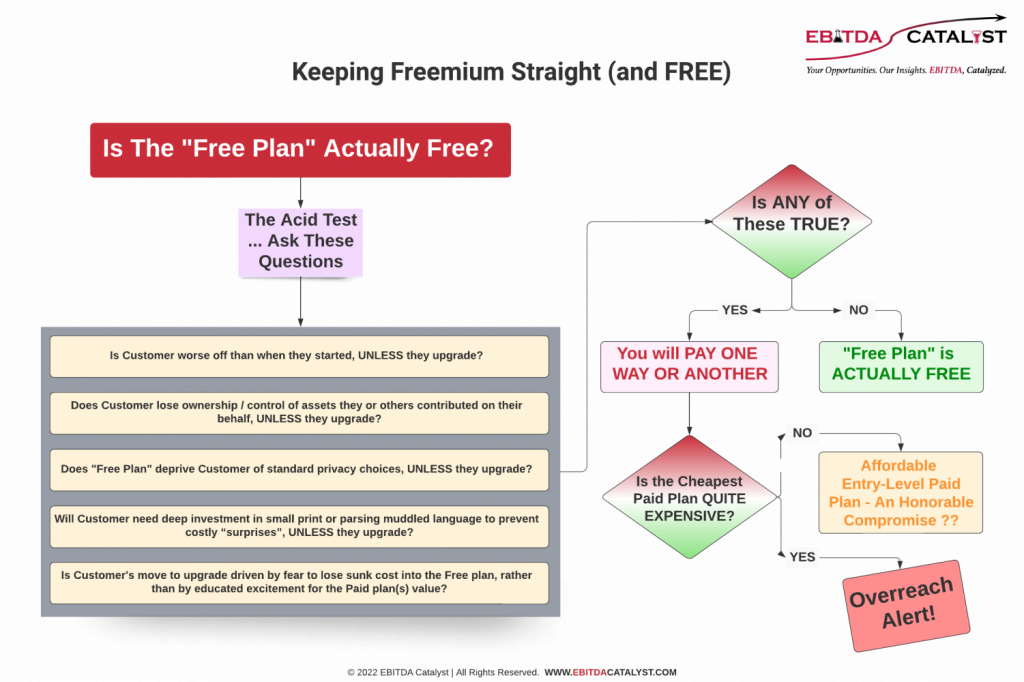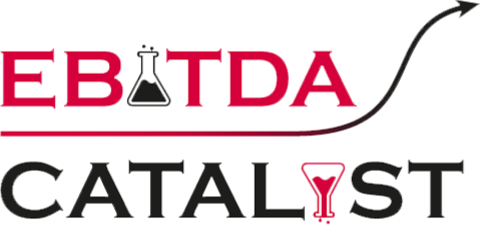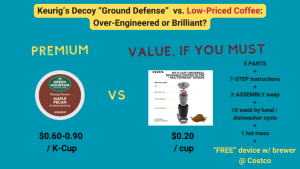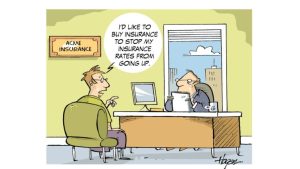Part #1 of 2. Part #2 is published as a separate post to illustrate a “case study” here.
The “Free Plan” Challenge
Freemium has become table stakes for myriad SaaS companies and the most successful customer acquisition tool for the SaaS industry as a whole. By providing genuine (even if limited) value and a risk-free way for customers to experience the product, SaaS companies use the Free plan to create a wide funnel. From the Free plan, customers who perceive sufficient value can seamlessly move into paid plans.
Sadly, some SaaS companies overreach in their hunger to monetize more, sooner. We recently ran into a “case study” that led us to reflect on freemium done right vs done poorly.
In this article we ask the questions:
- When is a SaaS Free Plan (Freemium) not actually free?
- Where is the fine line between freemium SaaS “audacious monetization” and “breach of trust”?
Below, I propose some “acid test” for the questions above, and illustrate with a real life example.
(Note: All references to a specific company name have been removed. The purpose of this is not to pick on specific companies, but to propose ideas and guide rails that may serve in the marketplace).
The Acid Test: When Is the “Free Plan” Actually NOT Free?
Each of the situations below would signal the plan carries either hidden, implied, or delayed costs:
- When it leaves users worse off than where they started, if they choose not to upgrade; OR
- When it “appropriates” or denies users reasonable control of assets that they contributed or others contributed on their behalf, unless they upgrade; OR
- When it deprives users of standard privacy choices (like which content is public vs private) unless they upgrade; OR
- When it requires a deep investment in reading small print or parsing what seems like intentionally muddled language to prevent costly “surprises” and practices that one would not readily expect based on common industry practices; OR
- When users feel they must upgrade because they’re afraid to lose something of value if they stay on the Free plan, rather than because they’re excited to gain all the value ahead from the compelling things Paid plan(s) will enable.
Any of these situations can make users feel stuck, and unduly pressured to upgrade.
Bonus Acid Test: When Can The “Free Plan” Turn Quite Expensive?
Adding insult to injury (and a strong suspicion such a “Free Plan” is heading into a “gotcha strategy”), some SaaS companies that already failed the acid test above add a second “a-ha moment” of the unpleasant kind.
- The $ step-up even to the lowest-priced paid plan is unusually steep (0 to 100 mph in 2 seconds).
Recall, at least in theory (and certainly in the way smart SaaS companies engineer the frictionless “free sign-up”), the invitation is to experience the “Free Plan” before / without worrying about prices and the details of the various paid plans. The stated and implied purpose of the Free Plan is often positioned as “riskless, free experience of the value & features” that creates enough purchasing interest or intent to check out features, comparisons and prices for paid plans, etc.

Right-click -> Open In New Window if image is not large enough on your screen.
1st Prize Final Test: Where Is The Fine Line Between Freemium Saas “Audacious Monetization” And “Breach Of Trust”?
SaaS companies are under a lot of pressure to demonstrate they can monetize their offering and convert freemium customers into paid plans. There is a difference between smart pricing or creative monetization and gotcha tactics that risk alienating the very customers that invested in experiencing a free plan. The latter become case studies, chat room fodder, and credit card disputes.
Our final proposal for how to draw the fine line is by asking any company that appears to have overreached, to consider the “unsuspecting user” perspective. This leads to the final test … when we move from merely “not free”, to the one that risks giving a bad name to the practice overall:
When the company’s Customer “Success” team makes Free Plan users who express surprise feel like a “Failure” for not sniffing all this out sooner by reading all the fine print.
Some months ago, no less an ultimate authority on Customer Success than Nick Mehta, CEO of Gainsight, the “original” Customer Success company, posed a question to followers about what SaaS companies can do in this softening business climate. One idea we offered was to invest in customer stickiness, but “not the type companies purposefully build in to deprive customers of flexibility”. A “Free Plan” we can’t get out of without paying up certainly fits exactly “the type” we had in mind!
Conclusion
Freemium is popular for a reason, and most companies use it successfully and responsibly, providing great value to countless users to earn their trust first, and purchase later. Sometimes, the best way to give credit to the many SaaS companies who enrich our options with fabulous Free Plans, is to have the occasional reflection that such pricing execution takes real work and great user-centric decisions and experience … and some still get it wrong.
Next week, we illustrate with a real-world case study that seems to come on the “overreach” side of ALL the tests above …
UPDATE: Part #2, the case study, is now published here.





